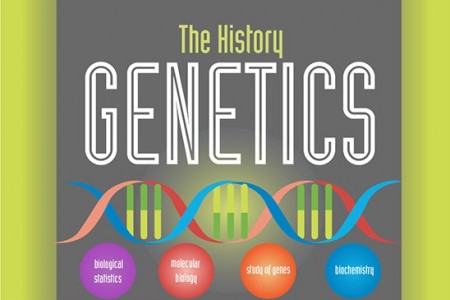
It all started with a man and his plants.
They were pea plants. Their flowers were different colors, their seeds different shapes. Some were long and others short. When two long plants were cross-bred, the result was always another long plant. The next generation, however, would see a smattering of short plants in a predetermined ratio of 1:3.
Gregor Mendel, a friar and scientist, was using peas to understand inheritance.
He began patiently breeding and further cross-breeding the plants in 1856. He counted, computed and meticulously recorded results. Nearly a decade later, he was satisfied. Though it would take forty years for his work to be appreciated, today he is considered the father of modern genetics.
Though modern genetics has very little to do with pea plants, it still has everything to do with genes.
Genes are the pieces of genetic information that each parent passes to their offspring. They can be dominant or recessive, and the relationship between each organism’s inherited genes will influence the traits to be expressed. Though he didn’t term the coin, Mendel discovered and explained genes.
The Physical Gene
A wave of studies conducted through the 1900s gave Mendel’s theoretical gene a physical form. In 1904, the chromosome was identified and found to behave similarly to Mendel’s described genes. Nettie Stevens discovered the sex chromosome, and Thomas Morgan Hunt found that traits could be sex-linked. We learned that genes are components of chromosomes. The theory that genes randomly cross over from one chromosome to another, trading various pieces and passing down a unique set, further explained genetic diversity.
Then we began to unravel the mysteries of deoxyribonucleic acid (DNA).
Oswald Avery revealed the function of DNA in 1944. It was the blueprint for life, a bundle of tightly bound chromosomes endowed to every cell with a nucleus. Shortly thereafter, the double-helix and importance of base-pairing to protein creation gave structure to function. It had been fewer than 100 years since Mendel had developed a reliable conception of genetics, and only 50 years since his work had been taken seriously. Progress had been quick, and we were just getting started.
Developing Genetic Tools
Observing, identifying, and understanding the molecular processes that govern genetics was only the first part of humanity’s gene-journey. People wanted to do something, and that required tools. Scientists began to study genetic processes in a new way. The goal was no longer solely to understand genes, but to learn how to mimic and manipulate them.
In 1958, when Arthur Kornberg and Severo Ochon first synthesized DNA in a test tube, genetic engineering became a reality instead of a far-fetched fantasy. The road was long when compared to our pace in deciphering the physical gene, but the challenges were more complex.
Every piece of the process needed to be understood well enough to replicate. Failed experiments represented gaps in knowledge that needed to be meticulously filled. Scientists were recreating some of the most complex, life-sustaining molecular machinery known.
Incremental gains in knowledge and efficacy led to breakthrough tools. Our understanding of DNA endonuclease, used to cut open DNA at specific nucleotide sequences, and DNA ligase, used to join strands together, led to recombinant DNA in 1972. Scientists successfully inserted and expressed genes from one organism in another, calling it recombinant DNA.
Eleven years later, polymerase chain reaction (PCR) facilitated further DNA-based experimentation by providing a cost-effective method of creating trillions of identical segment copies. In 1996 we met Dolly, the first mammal to be cloned using a somatic cell. The entire human genome had been sequenced by 2003. It included three billion base pairs.
Personal genotyping, or sequencing segments of the DNA known to important for disease risk and other marketable factors like ancestry, is now available for roughly one hundred dollars online.
CRISPR, which scientists had been studying since 1987, made its debut as a quick and efficient gene editing tool in 2012. Though still in its infancy in terms of application and clinical trials, it has the potential to be a real game changer. Enthusiasts believe CRISPR can edit away a host of human diseases.
The Advent of Gene Therapies
As the science of genetics progresses, one of the most exciting developments is gene therapy. Old-fashioned human curiosity may have been a driver of genetic research, but a stronger driver was the desire to better understand and cure human disease. In gene therapy, normal genes are transplanted into a sick patient to give their cellular machinery a non-diseased version of the gene that is making them sick.
The first gene therapy recipient was a four-year old girl with adenosine deaminase (ADA) deficiency. Her immune system wasn’t working properly, making common illnesses life-threatening. Children with ADA rarely live into adulthood. With gene editing to her white blood cells, doctors were able to boost her immune system by 40 percent. It wasn’t a cure, the treatment needed to be repeated periodically to maintain these results, but it was only 1990.
Today, sixteen gene therapies are listed as approved by the FDA. Among them is a treatment to help kids with an inherited form of childhood blindness see and cell-based gene therapies used to treat leukemia. Other clinical trials are underway. Ever understanding, every process unveiled, brings us closer to clinical results.
Conclusion
From the humble beginnings of a man with his plants to demonstrated ability to cure diseases, genetics has come a long way. Progress continues and every year new diseases are made more bearable, more survivable. With the help of hard-working, visionary scientists who are aren’t afraid of the big questions, the possibilities are limitless.

Erin Wildermuth is a science writer based in Miami. She is passionate about using technology to improve human health.
